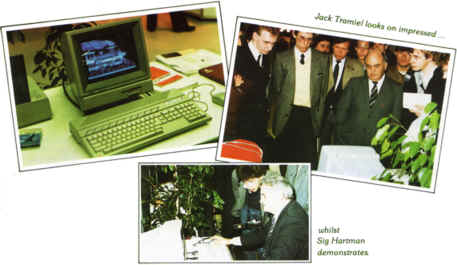AND THEN THERE WERE TWO…

Most of the talk in Hannover where
the 130XE and 520ST had their first Europe showings, was not about
what was there but more about what was not. For the uninitiated
it was probably quite an eye-opener but aside from actually seeing
several 520STs and 130XEs and a few peripherals I did not really
find anything new to report.
Nothing that is about what will
be happening but it looks now as if the 130ST will not be released
and that the 130XE may be the only 8-bit micro. Still that is not
as bad as it might seem at first sight. Two excellent and powerful
machines have a much better chance in the market than an assortment
of machines that users may or may not be interested in.
The ATARI stand featured a small
display of 130XEs and six 520STs in various configurations hooked
up to hard disks {yes!), 500k and 1Mb 3½" floppies, a synthesiser
and various monitors. The 130XE is reviewed elsewhere so let's concentrate
on the machines that caused the most excitement.
The 520ST really does work and
is very impressive. The demos being shown were mainly sixteen colour
'low- resolution' pictures that had been designed on an 800XL and
downloaded via the RS232 port. Colours were added after with a utility
program and although the graphics were excellent they only really
gave a hint of what might be produced by using the ST direct. There
were no software packages on show although the graphics of a spreadsheet
were used to demonstrate the ability to take any part of the image
and blow it up to different sizes. Another demo showed a multicoloured
pie chart which drifted apart in segments and smoothly rejoined.
The watching crowd were impressed. Jack Tramiel was impressed too!
Two 3 ½" drives were shown, the
500k SF354 and the 1 Mb. SF314 which both appeared to be working
well. The advantage of 3 ½" disks was shown by an Atari employee
jealously guarding a flight bag full of them which he grabbed and
threw back as needed. Try to do that with a 5 ¼" floppy! Several
prototype hard disks in adapted 1050 cases were being used although
nobody would say what for. I suspect that part of the Operating
System or GEM was actually on disk. There were also a number of
printers but none of them were shown working so I could not tell
how good or otherwise they might be.
Three monitors were on display,
including one with built in disk drive that may never be produced,
and they were all excellent in both style and display. That goes
for all the range. It has class.

As regards the hardware, although
everything was new, nothing much was 'news' but what did impress
me was the way Jack Tramiel viewed the ST and the future. His image
is built up as the hard-hitting, anything-goes, businessman who
just wants to make money but the way he stood and admired the ST
along with the general public showed that he cares about much more
than the money. He knows that the ST is a great computer and even
though he may not know how it works (!) he is visibly proud of having
achieved a major breakthrough in personal computing. Sure he wants
to make money but he is also enjoying every minute of producing
some great computers and that is important to every existing and
future Atari user. He kept standing there as the demos were coming
up saying "Show' em the one I like. Look at that, isn't it great?".
top